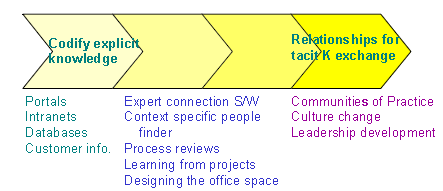
Elements of Knowledge Management:
Codify explicit knowledge: Portals, Intranets, Databases, Customer info
In process – expert connection, context specific people finder, process reviews, learning from projects, designing the office space
Relationships for tacit knowledge exchange: Communities of practice, culture change, leadership development
Principle:
| Step | Key Question | Action |
| 1 | How do you want to play the game? | Articulate desired or intended strategy |
| 2 | What do you need to know? | Articulate strategy -> knowledge link |
| 3 | What do you know? | Create internal knowledge map |
| 4 | What’s your internal knowledge gap? | Compare what you need to know to what you do know |
| 5 | What do your competitors know? | Create external (competitor/industry) knowledge gap |
| 6 | What’s your external knowledge gap? | Compare what you know to what your competitors know |
| 7 | What is your learning cycle? | Assess your dynamic learning capabilities and intentions |
| 8 | What are your competitors’ and industry’s learning cycles and capabilities? | Assess yur industry’s and competitors dynamic learning capabilities and intentions |
| 9 | What is your learning gap? | Compare your dynamic learning capabilities to those of your competitors and your industry |
| 10 | What’s your internal strategic gap? | Assess how your internal knowledge gap affects your current strategy |
| 11 | What’s your external strategic gap? | Assess how your external knowledge gap affects your current strategy |
| 12 | What’s your industry cycle strategic gap? | Assess how your dynamic learning gap affects your future strategy |
| 13 | What’s your current and future strategy? | Determine if and how your knowledge and learning gaps require a revision in strategy |
| 14 | What’s your knowledge strategy? | Determine how aggressive you will be to close your knowledge gaps, *Regarding exploration vs exploitation, *Regarding internal vs external sources |
Issues:
People – Process – Technology
Truch, 2001: Both Exploration and Exploitation must be incorporated to be successful
Knowledge management Forum, HMC: Benefits are:
Cost reduction, improved competitiveness, knowledge intensity, developing culture, increasing effectiveness, RO technology I
Applications:
To create a link between strategy and what people need to know
Source of Knowledge Management:
(Zack, 1999)






